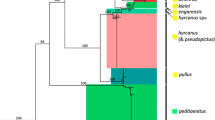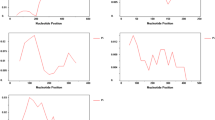Abstract
The Anopheles (Anopheles) Hyrcanus group of mosquitoes is very important for human health because some are malarial vector mosquitoes. Despite their pathological importance, some unidentified internal transcribed spacer 2 (ITS2) sequences have been reported from members of this group, and their phylogenetic relationships have been rarely understood. In the present study, 84 ITS2 sequences for the Hyrcanus group members were retrieved from GenBank. The detailed sequence comparison unambiguously revealed that the unknown1 sequences of Li et al. (Zootaxa 939:1–8, 2005), YM-2004 (or sp.2) of Ma and Xu [J Med Entomol 42(4):610–619, 2005], Anopheles sp. of Ree et al. (2005), and Anopheles lesteri reported by Gao et al. [J Med Entomol 41(1):5–11, 2004] are identical to Anopheles belenrae [Rueda (Zootaxa 941:1–26, 2005)] and that YM-2003 (or sp.1) of Ma and Xu [J Med Entomol 42(4):610–619, 2005] is closely related to A. lesteri. In addition, some candidate species that may be synonymized are suggested in addition to the possibility that A. lesteri may be divided into at least three types: A, B, and C. The neighbor joining, maximum parsimony, and maximum likelihood trees show that the 23 examined Hyrcanus group members could be divided into four subgroups. The phylogenetic relationships among them are generally well resolved with high bootstrapping values (60–100%), and they are consistently supported by all three trees without any conflicts. These results may strongly suggest that the morphology-based groupings of the Hyrcanus group members should be seriously reconsidered. Further study must be conducted to address the following issues: the three or more multitypified A. lesteri; the unidentified YM-2003 closely related to A. lesteri; and the synonymies of Anopheles peditaeniatus/Anopheles nigerrimus, Anopheles kunmingensis/Anopheles liangshanensis, Anopheles pullus/Anopheles junlianensis, and Anopheles engarensis/Anopheles kleini.


Similar content being viewed by others
References
Gao Q, Beebe NW, Cooper RD (2004) Molecular identification of the malaria vectors Anopheles anthropophagus and Anopheles sinensis (Diptera: Culicidae) in central China using polymerase chain reaction and appraisal of their position within the Hyrcanus group. J Med Entomol 41(1):5–11
Harbach RE (2004) The classification of genus Anopheles (Diptera: Culicidae): a working hypothesis of phylogenetic relationships. Bull Entomol Res 94(6):537–553
Harbach RE, Kitching IJ (2005) Reconsideration of anopheline mosquito phylogeny (Diptera: Culicidae: Anophelinae) based on morphological data. Syst Biodivers 3(4):345–374
Hwang UW, Yong TS, Ree HI (2004) Molecular evidence for synonymy of Anopheles yatsushiroensis and An. pullus. J Am Mosq Control Assoc 20(2):99–104
Hwang UW, Tang TH, Kobayashi M, Yong TS, Ree HI (2006) Molecular evidence supports that Anopheles anthropophagus from China and Anopheles lesteri from Japan are the same species. J Am Mosq Control Assoc 22(2):324–326
Kanda AT, Oguma Y (1978) Anopheles engarensis new species related to Anopheles sinensis from Hokkaido Island, Japan. Mosq-Syst 10(1):45–52
Kim HC, Lee KW, Klein TA, Strickman DA (1999) Seasonal prevalence of mosquitoes collected from light trap in Korea (1995–1996). Korean J Entomol 29:181–187
Li C, Groebner JL, Kim HC, Klein TA, O’Guinn ML, Wilkerson RC (2005) A newly recognised species in the Anopheles hyrcanus group and molecular identification of related species from the Republic of South Korea (Diptera: Culicidae). Zootaxa 939:1–8
Ma YJ, Xu JN (2005) The Hyrcanus group of Anopheles (Anopheles) in China (Diptera: Culicidae): species discrimination and phylogenetic relationships inferred by ribosomal DNA internal transcribed spacer 2 sequences. J Med Entomol 42(4):610–619
Ma Y, Yang P (2005) Taxonomic study on Anopheles anthropophagus from China (Diptera: Culicidae): inferred by morphology, chromosome karyotype and molecular markers. Kun Chong Fen Lei Xue Bao 27(3):199–208
Min GS, Choochote W, Jitpakdi A, Kim SJ, Kim W, Jung J, Junkum A (2002) Intraspecific hybridization of Anopheles sinensis (Diptera: Culicidae) strains from Thailand and Korea. Mol Cell 14:198–204
Park SJ, Choochote W, Jitpakdi A, Junkum A, Kim SJ, Jariyapan N, Park JW, Min GS (2003) Evidence for a conspecific relationship between two morphologically and cytologically different forms of Korean Anopheles pullus mosquito. Mol Cell 16:354–360
Posada D, Crandall KA (1998) MODELTEST: testing the model of DNA substitution. Bioinformatics 14(9):817–818
Ree HI, Hong HK, Paik YH (1967) Study on natural infection of Plasmodium vivax in Anopheles sinensis in Korea. Korean J Parasitol 5:65–68
Ree HI, Yong TS, Hwang UW (2005) Identification of four species of the Anopheles hyrcanus complex (Diptera: Culicidae) found in Korea using species-specific primers for polymerase chain reaction Assay. Med Entomol Zool 56(3):201–205
Rueda LM (2005) Two new species of Anopheles (Anopheles) Hyrcanus group (Diptera: Culicidae) from the Republic of South Korea. Zootaxa 941:1–26
Rueda LM, Wilkerson RC, Li C (2005) Anopheles (Anopheles) lesteri Baisas and Hu (Diptera: Culicidae): neotype designation and description. Proc Entomol Soc Wash 107(3):604–622
Sawabe K, Takagi M, Tsuda Y, Tuno N (2003) Molecular variation and phylogeny of the Anopheles minimus complex (Diptera: Culicidae) inhabiting Southeast Asian countries, based on ribosomal DNA internal transcribed spacers, ITS1 and 2, and the 28S D3 sequences. Southeast Asian J Trop Med Public Health 34(4):771–780
Shin EH, Hong HK (2001) A new synonym of Anopheles (Anopheles) pullus Yamada, 1937-A. (A.) yatsushiroensis Miyazaki, 1951. Korean J Entomol 31:1–5
Swofford DL (2002) PAUP* (phylogenetic analysis using parsimony) version 4.0beta10. Sinauer, Sunderland
Thompson JD, Gibson TJ, Plewniak F, Higgins DG (1997) The Clustal X windows interface flexible strategies for multiple sequence alignment aided by quality analysis tools. Nucleic Acids Res 25:4876–4882
Wilkerson RC, Li C, Rueda LM, Kim HC, Klein TA, Song GH, Strickman D (2003) Molecular confirmation of Anopheles (Anopheles) lesteri from the Republic of South Korea and its genetic identity with An. (Ano.) anthropophagus from China (Diptera: Culicidae). Zootaxa 378:1–14
Xu JJ, Feng LC (1975) Studies on Anopheles hyrcanus group of mosquitoes in China. Acta Entomol Sin 18:77–104
Acknowledgements
I express special thanks to Prof. Han Il Ree (Department of Parasitology, College of Medicine, Yonsei University) for his valuable comments on this work. Also, I heartily thank Prof. Gonzalo Giribet (Department of Organismic and Evolutionary Biology, Harvard University, Cambridge, MA) for providing me with a Museum of Comparative Zoology office and molecular lab facilities so that I could finish writing this manuscript.
Author information
Authors and Affiliations
Corresponding author
Additional information
This work was supported by the Korea Science and Engineering Foundation (KOSEF) grant funded by the Ministry of Science and Technology (MOST) of Korea (R01-2004-000-10930-0) awarded to UWH.
Rights and permissions
About this article
Cite this article
Hwang, U.W. Revisited ITS2 phylogeny of Anopheles (Anopheles) Hyrcanus group mosquitoes: reexamination of unidentified and misidentified ITS2 sequences. Parasitol Res 101, 885–894 (2007). https://doi.org/10.1007/s00436-007-0553-4
Received:
Accepted:
Published:
Issue Date:
DOI: https://doi.org/10.1007/s00436-007-0553-4




